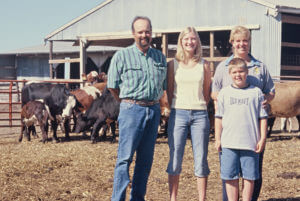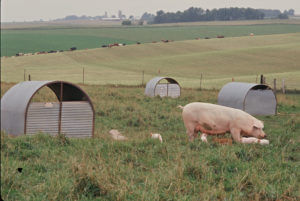Sustainable Agriculture Policy from the Ground Up
March 22, 2022Dave Serfling & The Farmer-led Movement to Create a Groundbreaking Conservation Program
By Brian DeVore, Editor with the Minnesota-based Land Stewardship Project and the author of Wildly Successful Farming: Sustainability and the New Agricultural Land Ethic.
 It was the summer of 2005, and Dave Serfling was ecstatic. The 350 acres he and his wife Diane were raising crops and livestock on in southeastern Minnesota had just enrolled in a new USDA conservation program that paid farmers for producing environmental benefits on working farmland. I had called Dave to talk about the implementation of what was then called the “Conservation Security Program,” and he informed me that a 2,000-acre crop operation in his watershed was also enrolled in CSP but didn’t qualify for as much money through the program.
It was the summer of 2005, and Dave Serfling was ecstatic. The 350 acres he and his wife Diane were raising crops and livestock on in southeastern Minnesota had just enrolled in a new USDA conservation program that paid farmers for producing environmental benefits on working farmland. I had called Dave to talk about the implementation of what was then called the “Conservation Security Program,” and he informed me that a 2,000-acre crop operation in his watershed was also enrolled in CSP but didn’t qualify for as much money through the program.
Why? It turns out the program was going to reward Dave and Diane not based on how many acres of corn they raised, but on how much of a positive impact they were having on the landscape. Over the years, they had established diverse crop rotations, rotational grazing and perennial systems like hay and pasture, and they had plans for putting in more of what today would be called “regenerative” practices. In a region where rain can send soil flying off steep hillsides and karst geology makes groundwater vulnerable to contamination, the Serflings felt this was the only way to farm. And now, for the first time, government policy, and indirectly, society itself, were recognizing that fact as well.
“This never happened in the commodity program, where I actually was paid more than the big cropping operations,” Serfling told me.
But he wasn’t bragging about a financial windfall at the expense of a fellow farmer. Serfling was simply expressing amazement that for once his diverse production techniques were not being penalized by policy. And CSP wasn’t prescribing how to farm. Rather, it was providing goals—cleaner water, less erosion, more wildlife habitat, for example—and then leaving it up to the farmers to creatively reach them. That’s exactly what Serfling had in mind when, a few years before, he walked into a meeting of the Land Stewardship Project’s (LSP) Federal Farm Policy Committee with an 11-page proposal to revamp federal farm conservation policy. His fellow farmers on the committee went over the proposal, and with the assistance of then-LSP policy director Mark Schultz, hammered out an initiative that, rather than promote the production of more monocrops, would reward results-oriented whole-farm conservation practices on working land. This was groundbreaking—federal farm conservation programs have traditionally relied on retiring acres via initiatives such as the Conservation Reserve Program and funding the establishment of piecemeal projects such as terraces that don’t always produce the results intended.
“Dave’s idea was that policy ought to reward farming practices that create public goods,” recalled Schultz, who recently retired as the executive director of LSP, a Minnesota-based grassroots sustainable farming organization.
A working land conservation program that took a whole-farm approach resonated with Tom Harkin, who was then a U.S. senator from Iowa and chair of the Senate ag committee. After meeting with Serfling and other members of the LSP committee, Harkin made CSP part of the 2002 Farm Bill.
What is now called the Conservation Stewardship Program is, by farm acreage covered, the largest federal conservation program in the country—at least 70 million acres of crop, forest, pasture and rangeland are enrolled in the program. I’ve been on dozens of CSP farms that are using an array of innovative practices to save soil, protect water, build carbon and provide wildlife habitat.
Unfortunately, Serfling never had the opportunity to see his vision fully realized. Less than a year after he signed that CSP contract, he was killed in an auto accident. He was only 46 at the time, and it’s astounding the impact he had on regenerative agriculture, policy and his local community in such a short time.
 Besides being a key player in the development of one of the most innovative farm conservation programs in history, Serfling was deeply involved in on-farm research and farmer-to-farmer education. The Serfling farm was frequently featured in local and national media, and Serfling himself was an eloquent and effective communicator. His presentations, essays and fact sheets blended the farmer’s razor-sharp analysis of numbers with his own family’s experience as land stewards. Serfling had a knack for expressing to non-farmers the joys of making a living on the land. “As you can probably tell, I love farming,” he wrote in one newspaper commentary that described in loving detail the life he and Diane, along with their children, Hannah and Ethan, had on those 350 acres.
Besides being a key player in the development of one of the most innovative farm conservation programs in history, Serfling was deeply involved in on-farm research and farmer-to-farmer education. The Serfling farm was frequently featured in local and national media, and Serfling himself was an eloquent and effective communicator. His presentations, essays and fact sheets blended the farmer’s razor-sharp analysis of numbers with his own family’s experience as land stewards. Serfling had a knack for expressing to non-farmers the joys of making a living on the land. “As you can probably tell, I love farming,” he wrote in one newspaper commentary that described in loving detail the life he and Diane, along with their children, Hannah and Ethan, had on those 350 acres.
Perhaps Serfling was his most animated when he talked about working with livestock. He loved figuring out how to balance care of the land with profitable production of hogs, cattle, sheep and chickens, and he saw animals as playing an integral role in creating a diverse, sustainable operation with a tight nutrient cycle. That’s why it made sense that the Serflings were early award-winning farmers for Niman Ranch.
It’s fitting that Serfling is closely associated with an innovative piece of policy like CSP. Its foundation was built on the ideal that when given a chance, farming can have a positive impact on the land, people and community. Dave Serfling lived that ideal every day.
LEARN MORE: Read Niman Ranch’s 2021 Impact Report
